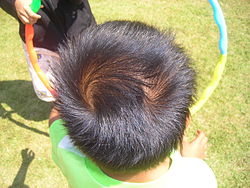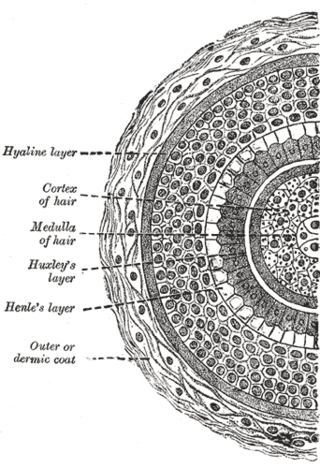
Hair is a protein filament that grows from follicles found in the dermis. Hair is one of the defining characteristics of mammals. The human body, apart from areas of glabrous skin, is covered in follicles which produce thick terminal and fine vellus hair. Most common interest in hair is focused on hair growth, hair types, and hair care, but hair is also an important biomaterial primarily composed of protein, notably alpha-keratin.

A hairstyle, hairdo, haircut, or coiffure refers to the styling of hair, usually on the human head but sometimes on the face or body. The fashioning of hair can be considered an aspect of personal grooming, fashion, and cosmetics, although practical, cultural, and popular considerations also influence some hairstyles.

The crab louse or pubic louse is an insect that is an obligate ectoparasite of humans, feeding exclusively on blood. The crab louse usually is found in the person's pubic hair. Although the louse cannot jump, it can also live in other areas of the body that are covered with coarse hair, such as the perianal area, the entire body, and the eyelashes.
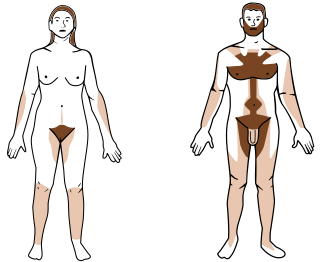
Hair removal is the deliberate removal of body hair or head hair. This process is also known as epilation or depilation.
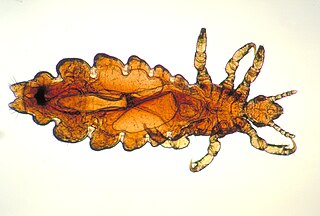
Pediculosis is an infestation of lice from the sub-order Anoplura, family Pediculidae. Accordingly, the infestation with head lice is named pediculosis capitis, while this with body lice, pediculosis corporis. Although pediculosis in humans may properly refer to lice infestation of any part of the body, the term is sometimes used loosely to refer to pediculosis capitis, the infestation of the human head with the specific head louse.

Hair loss, also known as alopecia or baldness, refers to a loss of hair from part of the head or body. Typically at least the head is involved. The severity of hair loss can vary from a small area to the entire body. Inflammation or scarring is not usually present. Hair loss in some people causes psychological distress.
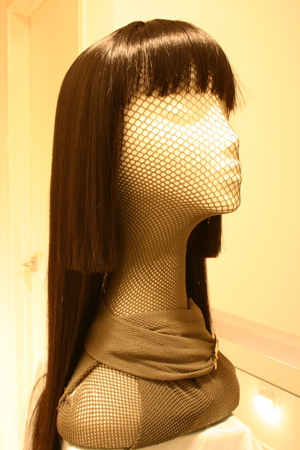
A wig is a head covering made from human or animal hair, or a synthetic imitation thereof. The word is short for "periwig". Wigs may be worn to disguise baldness, to alter the wearer's appearance, or as part of certain professional uniforms.

Human hair color is the pigmentation of human hair follicles and shafts due to two types of melanin: eumelanin and pheomelanin. Generally, the more melanin present, the darker the hair. Its tone depends on the ratio of black or brown eumelanin to yellow or red pheomelanin. Melanin levels can vary over time, causing a person's hair color to change, and one person can have hair follicles of more than one color. Some hair colors are associated with some ethnic groups because of the observed higher frequency of particular hair colors within their geographical region, e.g. straight, dark hair amongst East Asians, Southeast Asians, Polynesians, some Central Asians, and Native Americans; a large variety of dark, fair, curly, straight, wavy or bushy amongst Europeans, West Asians, some Central Asians, and North Africans; and curly, dark, and uniquely helical hair amongst Sub Saharan Africans. Bright red hair is found in some European populations, and hair turns gray, white, or "silver" with age.

Folliculitis is the infection and inflammation of one or more hair follicles. The condition may occur anywhere on hair-covered skin. The rash may appear as pimples that come to white tips on the face, chest, back, arms, legs, buttocks, or head.

An eyebrow is an area of short hairs above each eye that follows the shape of the lower margin of the brow ridges of some mammals. In humans, eyebrows serve two main functions: first, communication through facial expression, and second, prevention of sweat, water, and other debris from falling down into the eye socket. It is common for people to modify their eyebrows by means of hair removal and makeup.

The vestibular system, in vertebrates, is a sensory system that creates the sense of balance and spatial orientation for the purpose of coordinating movement with balance. Together with the cochlea, a part of the auditory system, it constitutes the labyrinth of the inner ear in most mammals.

A hairbrush is a brush with rigid or light and soft spokes used in hair care for smoothing, styling, and detangling human hair, or for grooming an animal's fur. It can also be used for styling in combination with a curling iron or hair dryer.

Goose bumps, goosebumps or goose-pimples are the bumps on a person's skin at the base of body hairs which may involuntarily develop when a person is tickled, cold or experiencing strong emotions such as fear, euphoria or sexual arousal.

Aders's duiker, also known as nunga in Swahili, kunga marara in Kipokomo and harake in Giriama, is a small, forest-dwelling duiker found only in Zanzibar and Kenya. It may be a subspecies of the red, Harvey's, or Peters's duiker or a hybrid of a combination of these. It is named after W. Mansfield Aders, a zoologist with the Zanzibar Government Service.
Hair fetishism, also known as hair partialism and trichophilia, is a partialism in which a person sees hair – most commonly, head hair – as particularly erotic and sexually arousing. Arousal may occur from seeing or touching hair, whether head hair, armpit hair, chest hair or fur. Head-hair arousal may come from seeing or touching very long or short hair, wet hair, certain colors of hair or a particular hairstyle.

Dermatophytosis, also known as tinea and ringworm, is a fungal infection of the skin, that may affect skin, hair, and nails. Typically it results in a red, itchy, scaly, circular rash. Hair loss may occur in the area affected. Symptoms begin four to fourteen days after exposure. The types of dermatophytosis are typically named for area of the body that they affect. Multiple areas can be affected at a given time.
Artificial hair integrations, more commonly known as hair extensions, hair weaves, and fake hair add length and fullness to human hair. Hair extensions are usually clipped, glued, or sewn on natural hair by incorporating additional human or synthetic hair. These methods include tape-in extensions, clip-in or clip-on extensions, micro/nano rings, fusion method, weaving method, and wigs.

Markings on horses are usually distinctive white areas on an otherwise dark base coat color. Most horses have some markings, and they help to identify the horse as a unique individual. Markings are present at birth and do not change over the course of the horse's life. Most markings have pink skin underneath most of the white hairs, though a few faint markings may occasionally have white hair with no underlying pink skin. Markings may appear to change slightly when a horse grows or sheds its winter coat, however this difference is simply a factor of hair coat length; the underlying pattern does not change.

Head lice infestation, also known as pediculosis capitis, is the infection of the head hair and scalp by the head louse. Itching from lice bites is common. During a person's first infection, the itch may not develop for up to six weeks. If a person is infected again, symptoms may begin much more quickly. The itch may cause problems with sleeping. Generally, however, it is not a serious condition. While head lice appear to spread some other diseases in Africa, they do not appear to do so in Europe or North America.
Hairline lowering is a surgical technique that allows an individual to have their frontal hairline advanced certain distances depending on variables such as pre-operative hairline height, scalp laxity, and patient preference. It can be used to address a congenitally high hairline or sometimes a hairline that has recessed from hair loss. It is performed mostly on women.
